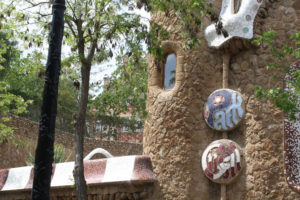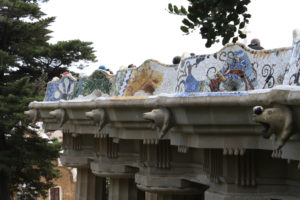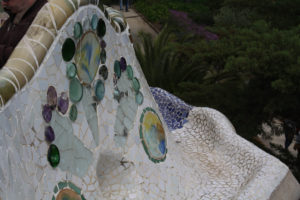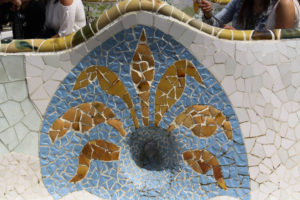
“There are no straight lines or corners in nature. Therefore, buildings must have no straight lines or sharp corners.” Antioni Gaudi
That quote rings true when you walk through Park Güell in Barcelona.

Park Güell was commissioned by Eusebi Güell who wanted to create a stylish park for Barcelona aristocracy. When he acquired this large estate in the late 1800s, he deemed it the perfect place for a park worthy of his wealthy clientele. After all, the views looking out over the sea and all of Barcelona were unbeatable. His plan was to design and then sell the plots.
He hired Antoni Gaudi, a practitioner of Catalan Modernism. Gaudi already had built or was in the process of building a wine cellar in El Garraf, the church of the Colonia Gruell, Palacio Güell, Casa Mila, Casa Vicens, work on the Nativity façade and crypt of La Sagrada Familia. Quite the architect.

His vision was that the 60 triangular plots with their complex network of roads, viaducts, and stairs would wind through the estate. All this while working within severe restrictions. Only one sixth of the entire plot could be built and he had to stay within the height requirements, so he didn’t disturb the views of other residents.
Gaudi respected the existing vegetation, like carob trees and olive groves. When he introduced new species, he chose Mediterranean plants. He also devised systems for collecting and storing water from the cooking systems he learned as a child.
All good ideas.
However, the complex conditions of the sale of plots, old contracts, the lack of adequate transportation, and the very exclusive character of the urbanization made it unfeasible. In the absence of buyers, the works were abandoned in 1914. Only two of the 60 planned houses had been built. The park thus became a large private garden, which Güell ceded for public events. At this time, it began to appear in the tourist guides of Barcelona as one of the attractions of the city.
Eusebi Güell died in his house in Park Güell in 1918 and his heirs offered the park to the City Council. In 1926 it was opened as a municipal park. The house of the Güell family was qualified as a public school, which took the name of Baldiri Reixac pedagogue.
Thanks to the work of Gaudí’s Friends, Gaudí’s house at the Park Güell opened to the public as a Casa Museu Gaudí in 1963.

Park Güell thus became a public park highly valued by the locals and an important focus of attraction for visitors. It was recognized as an artistic monument in 1969 and was declared World Cultural Heritage by UNESCO in 1984.
Walk around. It’s not hard to imagine this as a planned urban development. Views are spectacular. I mean…who wouldn’t want to live here?
At the top of the park is a terraced area where you can view the entire park and Barcelona. Take some time to sit on one of the many vibrant, multi-colored tiled mosaic seats. They look hard and not very comfortable. Just sit. The way they are constructed provides a delightful seat with just the right amount of back support. Trust me, you’ll want to sit here and enjoy the afternoon.
Gaudi’s use of colored tile is everywhere. I do mean everywhere. I love the famous Gaudi dragon fountain at the entrance. Everyone wants their picture taken with it.
Try to envision yourself living here. Even in the early 1900s, this would have been the place to be. It’s that special.
Every time we thought we had seen it all, something new caught our eye. As we left, we meandered through the central walkway, supported by twisting rock pillars that appear to be growing right out of the ground. It was easy to see how Gaudi used nature in his design. It’s evident throughout.
We planned on spending a couple of hours here. It stretched to more than that.
If You Go: Park Güell is located on Olot street in Barcelona. To reach in the most convenient and practical way in the Monumental Axis three accesses are recommended: the one of the street of Larrard (main entrance), the one of the highway of the Carmel, no. 23, where there is also the car park for tourist coaches, and a third, the one from the pass of Sant Josep de la Muntanya, which is accessed by escalators. Be prepared for a lot of walking.